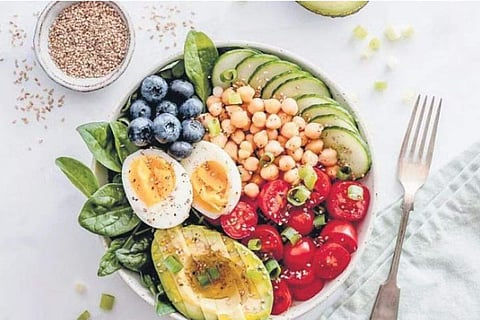
- LIFESTYLE
- FASHION
- FOOD
- ENTERTAINMENT
- EVENTS
- CULTURE
- VIDEOS
- WEB STORIES
- GALLERIES
- GADGETS
- CAR & BIKE
- SOCIETY
- TRAVEL
- NORTH EAST
- INDULGE CONNECT

A happy testimonial by a follower of dietician Courtney Kassis's '90-30-50’ four-week-long diet programme reads, “By the fourth day, I felt so much better, and had more energy. The recipes are easy to follow. This is my second week, and I have lost five pounds (2.2 kg). All my bloating is gone and I sleep much better.” The woman, going through menopause, discovered Kassis's videos, promising sustained weight loss, on TikTok. She had gained 15 pounds (roughly 7 kg) while navigating the perils of changing hormones and the stress of being a working mother to four. Further, she suffered from Sjogrens (an immune system disorder), fibromyalgia (chronic disorder that causes pain), arthritis, irritable bowel syndrome and insomnia.
This is one of the many success stories that Kassis—who goes by @dietiticianwithtwins on Instagram and has a following of 145k—shares on her page, apart from snippets of her own journey of weight loss, through which she supposedly cured her autoimmune disorder, Hashimoto’s thyroiditis. Her 90-30-50 diet programme advocates consuming a minimum of 90 grams of protein, 30 grams of fibre and 50 grams of healthy fats per day. According to Kassis, if you follow this principle, you can lose weight, reduce the symptoms of chronic disease, correct hormonal imbalances, control blood sugar levels and increase lean muscle mass.
It sounds miraculous, but is this new-fangled dieting trend actually healthy? Experts are divided. Aman Puri, founder of Steadfast Nutrition, a sports nutrition and wellness brand from Delhi, is wary of the fact that no study has been conducted to corroborate the results of the 90-30-50 concept. “It’s just a trending diet based on the personal experiences of a few people,” he says, adding that some people may not be able to gauge the right kind of healthy fats they need to consume daily. “Excess of even healthy fats can harm an individual’s health, especially those with high cholesterol levels,” he cautions.
The fact that this one-size-fits-all scheme does not address everyone’s fitness levels and personal concerns is clear from another user’s observation on one of Kassis’s videos. This person increased their protein intake to reach the goal of 90 gm per day and ended up gaining weight. “I obviously am overeating. How can I get to 90 grams of protein without overeating?” was the comment.
Goa-based nutrition and wellness consultant Sheela Krishnaswamy puts this down to the needs of individuals being different. She also feels that rapid fluctuations in dietary intake could impact one’s energy levels, micronutrient intake and level of satiety, which makes the diet a challenge to sustain. “In my opinion, this diet is more applicable to the western population whose requirements and eating habits are quite different from the Indians. Although it’s good to include adequate protein, fibre and healthy fats in our daily diet, by Indian standards, the protein quantity suggested in the 90-30-50 diet is quite high. It’s best to go with individual recommendations that are tailor-made by a qualified dietitian,” she says.
Being aware of what one’s body needs is essential to the success of any nutritional programme. To be fair, the advocates of the 90-30-50 diet also prescribe individual programmes to clients based on their needs, in exchange for a fee. Kochi-based blogger and holistic wellness coach focussing on nutrition and fitness, Rakhi Jayashankar, highlights the positive side of the fad, “Fortunately, it breaks the eons-old false notion that fats are bad. It encourages us to consume unsaturated fat and fibre, which is a prerequisite for your gut health and facilitates smooth digestion.” She adds that the followers of the programme will be high on energy as it concentrates on the consumption of macronutrients, and that the components of the diet may lead to quick weight loss as they help to curb cravings.
Dietary fads will come and go. For sustained and healthy weight loss and wellness goals, however, one must make holistic lifestyle changes. Dr. Rohini Somnath Patil, a doctor and nutritionist from Pune, summarises what this entails: “The only way to lose weight in the healthiest way possible is to look at your overall wellbeing, which includes physical, mental, social and emotional health.”
The Composition
90 g of protein
It is the minimal requirement for muscle development, muscle synthesis, regulation of normal metabolism and healthy functioning of the body
30 g of fibre
Helps with weight loss because fibre provides satiety and a feeling of fullness for a long duration, delaying frequent food cravings
50 g of healthy fat
Good fats enhance the diet’s texture and flavour
What Works
● Acknowledges the significance of essential nutrients for muscle maintenance and satiety
● Focuses on a higher protein percentage, which yields energy
● Recognises the role of healthy fats in supporting brain function and good gut health
● Enhances satiety and reflects a holistic approach to nutrition
The Downside
● People trying it on their own won’t be able to assess the correct quantities of carbs and micronutrients
● The same formula will not work for every individual. It must be customised.
● Constant measuring of food may become cumbersome
● There is potential for nutrient deficiencies